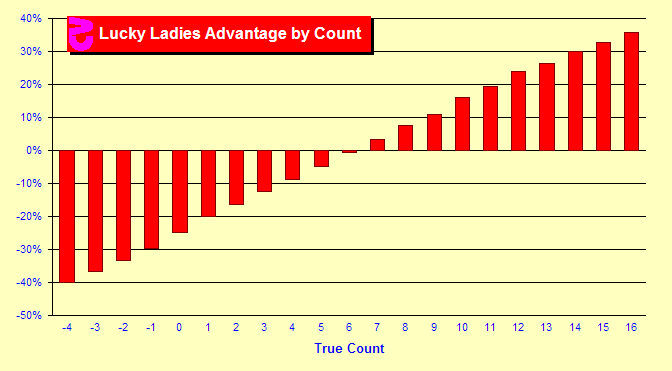Bondy3 said:
Hi,
I'm playing DD and counting using the hi-lo counting system (2,3,4,5,6 = +1 || T,J,Q,K,A = -1)
What are the odds of being delt a 20 (A9 or 2 tens/faces) based on what the TC is? is there a place I can find chats of this?
The reason I ask is because there is a side bet at the casino I play at (lucky ladies, but with a different payout table, I think its actually beatable instead of normal lucky ladies that is impossible to beat)
Thanks
-Bondy
I will use this question to test a program I am working on.
The input to the program:
1) tags of any counting system - count tags can be in the range of -25 to +25 although most will never even consider a tag of more than plus or minus 3. Range could even be increased without much problem.
2) running count of an input counting system
3) cards remaining to be dealt (i.e. penetration)
4) cards specifically known to be removed
The output of program:
1) probability of the input running count at the input penetration
2) probability of each rank given the specifically removed cards
An immediate application of the program would be to get precise insurance data/indices at every penetration level for any counting system. Data/indices could use only the fact that dealer's up card is an ace or could optionally and additionally use hand composition with reference to a count for a more informed decision. Of course data for every penetration would be overkill (but pen level is necessary to compute) so in order to get the big picture graphs could be generated.
Basically the program would be capable of outputting data and it would be up to the user to organize/use the data.
A more extended application would be to develop it into a full fledged combinatorial analyzer based upon probabilities generated from any given count although I may never get that far with it.
Anyway to answer the question, using a HiLo running count of +6 and no initial specific removals with 156 cards remaining as an example:
prob of 10 from starting condition = 0.32307692307692321
prob of 2nd 10 given a 10 was drawn on 1st card = 0.31961174253600266
prob of 10-10 = prob_tt = 0.10325917835778552
prob of ace from starting condition = 0.080769230769230801
prob of 9 given an ace was drawn on 1st card = 0.077182180370047898
prob of A-9 = prob_19 = 0.0062339453375807943
prob of 9 from starting condition = 0.076923076923076913
prob of ace given a 9 was drawn on 1st card = 0.081041289388550292
prob of 9-A = 0.0062339453375807909
prob20 = prob_tt + prob_19 + prob_91 = 0.11572706903294711
compare to:
full shoe prob20 = prob_tt + prob_19 + prob_91 = 0.1058619836754884986396240415533
(computed using Windows Calculator)
I would say that most could care less about this type of data but there is your answer albeit for 1 remote circumstance and also how it could be computed for other count conditions.

